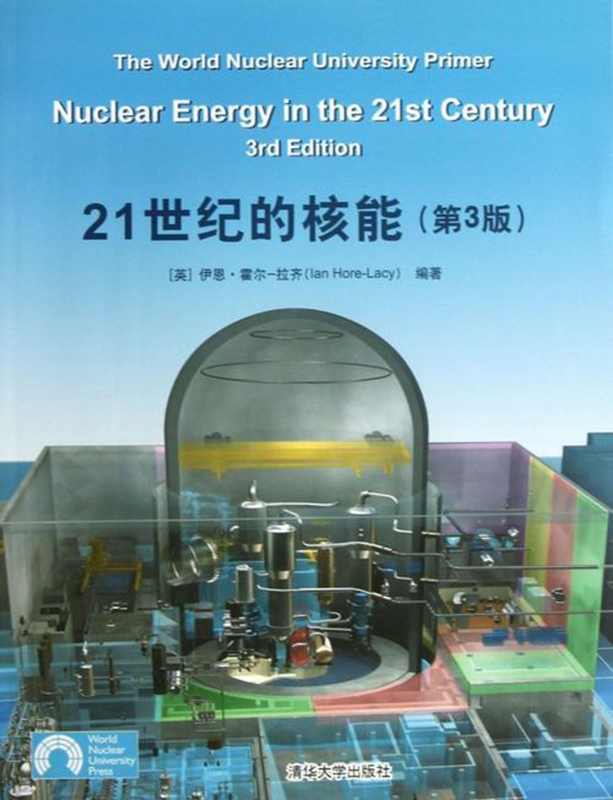《21世紀的核能》由清華大學出版社出版。內容豐富全面,涵蓋核能相關的各方面內容,敘述分析切到位,語言表達簡練而精確。
基本介紹
- 書名:21世紀的核能
- 作者:伊恩·霍爾-拉齊 (Ian Hore-Lacy)
- 出版日期:2013年5月1日
- 語種:簡體中文, 英語
- ISBN:9787302322474
- 出版社:清華大學出版社
- 頁數:135頁
- 開本:16
- 定價:48.00
基本介紹
內容簡介
作者簡介
伊恩·霍爾·拉齊(Ian Hore—Lacy),前生物學教師,1995年成為墨爾本鈾信息中心主管,並於2001年擔任總部位於倫敦的世界核能協會公共關係部主任。他曾經訪問過位於多個國家的大量核反應堆和燃料循環設施,其中包括英國燃料再加工廠、瑞典的核廢物處理廠、美國的核廢物信息庫和法國的濃縮鈾與氧化物混合燃料製造廠。他曾於1974年作為一名環境科學家從事過礦產有關工作,從中積累了大量與鈾礦有關的豐富經驗。在1988—1993年期間,他擔任CRA有限公司(在的Rio Tinto礦業集團)培訓和環境事務管理者。同期還發表了若干關於環境和礦產主題的著作。其涉足了包括有關礦產資源及其技術套用、社會倫理以及理論研究等諸多方面研究領域,特別是對核能研究具有濃厚的興趣。他膝下的四個孩子均已成年。這本書的早期版本還邀請了羅恩·胡珀作為合作作者。羅恩是一名化學工程師,現已退休。他曾與澳大利亞原子能委員會(ANSTO)在核燃料循環和再處置研究方面有過8年的合作經歷。他也曾在澳大利亞Rum Jungle和Marry Kathleen兩地的鈾生產中心工作過。
圖書目錄
Introduction
1.Energy use
1.1 Sources of energy
1.2 Sustainability of energy
1.3 Energy demand
1.4 Energy supply
1.5 Changes in energy demand and supply
1.6 Future energy demand and supply
2.Electricity today and tomorrow
2.1 Electricity demand
2.2 Electricity supply
2.3 Fuels for electricity generation today
2.4 Provision for future base—load electricity
2.5 Renewable energy sources
2.6 Coal and uranium compared
2.7 Energy inputs to generate electricity
2.8 Economic factors
3.Nuclear power and its fuels
3.1 Mass to energy in the reactor core
3.2 Nuclear power reactors – basic design
Panel: Components common to most types of nuclear reactor
3.3 Uranium availability
3.4 Nuclear weapons as a source of fuel
3.5 Thorium as a nuclear fuel
3.6 Accelerator—driven systems
3.7 Physics of a nuclear reactor
4.Types of nuclear power reactor
4.1 Today’s power reactors
4.2 Advanced power reactors
4.3 Floating nuclear power plants
4.4 Modular light water reactors
4.5 High temperature reactors
4.6 Fast neutron reactors
4.7 Very small nuclear power reactors
5.The ‘front end’ of the nuclear fuel cycle
5.1 Mining and milling of uranium ore
5.2 The nuclear fuel cycle
Panel: Uranium enrichment
5.3 Thorium cycle
6.The ‘back end’ of the nuclear fuel cycle
6.1 Nuclear wastes
6.2 Reprocessing used fuel
6.3 High—level wastes from reprocessing
Panel: Transporting radioactive materials
6.4 Storage and disposal of high—level wastes
6.5 Decommissioning nuclear reactors
7.Other nuclear energy applications
7.1 Transport
7.2 Hydrogen production and use
7.3 Process heat
7.4 Desalination
7.5 Marine propulsion
7.6 Radioisotope systems and reactors for space
7.7 Research reactors, making radioisotopes
8.Environment, health and safety
8.1 Greenhouse gas emissions
8.2 Other environmental effects
8.3 Health effects of power generation
8.4 Radiation exposure
8.5 Reactor safety
9.Avoiding weapons proliferation
9.1 International cooperation to achieve security
9.2 International nuclear safeguards
9.3 Fissile materials
9.4 Recycling military uranium and plutonium for electricity
9.5 Australian and Canadian nuclear safeguards policies
10.History of nuclear energy
10.1 Exploring the nature of the atom
10.2 Harnessing nuclear fission
10.3 Nuclear physics in Russia
10.4 Conceiving the atomic bomb
10.5 Developing the concepts: bomb and boiler
10.6 The Manhattan Project
10.7 The Soviet bomb
10.8 Revival of the ‘nuclear boiler’
10.9 Nuclear energy goes commercial
10.10 The nuclear power renaissance
Appendices
1.Ionising radiation and how it is measured
2.Some radioactive decay series
3.Environmental and ethical aspects of radioactive wastemanagement
4.Some useful references
Glossary
Index
名人推薦
——扎克·帕特 世界核運營協會名譽主席

